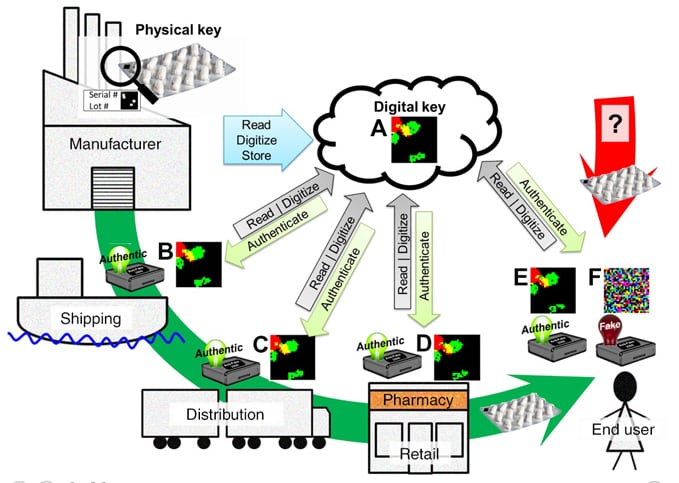The system is for pharmaceuticals and foodstuffs and could be on the market in a year.
Researchers have taken out a patent on the marking system and are fine-tuning scanning solutions to ready the system for manufacturers.
The pattern, measuring only a few millimeters, can be embedded into glass or milled into metal.
They said companies consistently suffer significant economic losses due to counterfeited goods made by pirate manufacturers.
System to clamp down on pirate manufacturing
Four researchers from the University of Copenhagen’s Nano Science Center developed a system that head of research and associate professor Thomas Just Sørensen, of the department of chemistry, calls the ‘safest in the world’ to clamp down on pirate manufacturing.
"The system, which deploys three rare earths among other things, is based on randomness, which makes it unable to be hacked or tampered with,” he said.
"As soon as a customer asks that an authorized dealer checks up on a piece of merchandise that was meant to be marked using the system…the dealer can access a manufacturer database to check its authenticity.
“The probability of two products having the same ‘fingerprints' – the same digital key – is so minuscule, that in practice, it can only be described as non-existent.”

The optical authentication system is based on lanthanide luminescence from physical one-way functions or physical unclonable functions (PUFs).
It will prevent counterfeiting if tags with unique PUFs are grafted onto products.
The authentication system is a hardware reader, image analysis and authentication software and physical keys.
Physical keys are made from zeolites doped with europium(III), terbium(III) or dysprosium(III) ions in a polyvinyl alcohol (PVA) thin film.
Physical keys are PUFs made from random patterns of taggants in polymer films on glass that can be imaged following selected excitation of particular lanthanide(III) ions doped into the individual taggants.
Upon each excitation wavelength, a unique random pattern emerges, and the digitized and combined pattern forms the unique digital key.
This form of excitation-selected imaging ensures by using at least two lanthanide(III) ion dopants, the random patterns cannot be copied, because the excitation selection will fail when using another emitter.
Identify through supply chain
Such a PUF key can be tagged onto every food product or blister pack of pills and each product will feature a unique key.
All physical keys are read and digital keys are stored in a database allowing each product to be uniquely identified throughout the supply chain.
Established technologies use tags that rely on access to the ink or printing technology, which makes them susceptible to counterfeiting.
Optical multiplexing has been done by incorporating multiple organic dyes or quantum dots in different ratios into microspheres but encoding capacity of microspheres with fluorescent dyes is limited.
The University of Copenhagen system uses statistically unique physical keys based on PUFs, which are based on non-deterministic, random features of the anti-counterfeiting tag, making it impossible to duplicate.
Researchers said economic benefit in upholding trademark and intellectual property rights is ‘substantial’.
“When used as an anti-counterfeiting system, the manufacturer tags a product with a unique physical key and records the digital key corresponding to the PUF key in a read-only public database.
“Merchants and end users can then verify the authenticity of the product using shop-based or personal readers that, knowing the type of product, look up the digital key in the corresponding manufacturers’ section of the database.
“The robust physical keys can either be grafted onto the product or supplied as thin films.”
Source: Science Advances 26 Jan 2018: Vol. 4, no. 1, e1701384
“An optical authentication system based on imaging of excitation-selected lanthanide luminescence”
Authors: Miguel R. Carro-Temboury, Riikka Arppe, Tom Vosch and Thomas Just Sørensen
